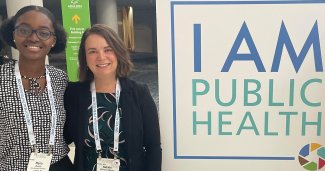
Community pharmacies in Ohio can play a role in supporting women who live in “maternity care deserts” or areas with low access to maternity care.
That’s according to Ohio Northern University researchers Natalie DiPietro Mager, PharmD ’01, Ph.D., and Maria Duodu who studied the issue.
The Journal of the American Pharmacists Association (JAPhA) published their study, “Provision of maternal health services among Ohio community pharmacists practicing in maternity care deserts” in November 2024.
DiPietro Mager is professor of pharmacy practice and Duodu is a pharmacy student. She will receive her undergraduate degree in May and her PharmD in 2027.
Their study was inspired by a report from the March of Dimes that more than 2.3 million American women of reproductive age live in counties without obstetrics services or providers. More than 3 million more live in counties with low access to these services.
“I thought pharmacists were underutilized resources for women’s health,” said DiPietro Mager. Pharmacists can play a role within their scope of practice or refer women to healthcare providers, she added.
The National Alliance of State Pharmacy Associations (NASPA) has created a toolkit outlining maternal health services pharmacists can provide before, during, and after pregnancy. Immunizations, blood pressure screenings, smoking cessation aid and alcohol screening/counseling are examples.
DiPietro Mager and Duodu’s study looked at whether community pharmacists in Ohio were aware they were in maternal care deserts or low-access care areas, and if they were using or interested in using the toolkit to help patients. No previous studies had examined these issues, according to the Journal article.
In the fall of 2023, they sent a survey to 216 community pharmacies in Ohio counties identified as maternity care deserts or low access areas.
Of those who responded, results showed that while almost half of the pharmacists were aware of rising maternal mortality rates, only 35% were aware they were practicing in a maternity care desert/low access area.
Hardin County, where ONU is located, is listed as a maternity care desert by the March of Dimes. While there are obstetrics clinics and hospitals in nearby counties, lack of transportation, inability to take time off work, or the need for childcare make it hard for women to make and keep maternal health appointments.
That’s where the community pharmacies can help. If a pregnant woman has high blood pressure, for example, DiPietro Mager said, “it might be easier for her to get to a local pharmacy for a blood pressure check than drive a longer distance to an appointment with a physician.”
In these low or no access areas, only 11% of the responding pharmacists were aware of the NASPA toolkit. While 90% of the pharmacies provided immunizations, only 11% offered alcohol use screening/counseling.
With an increasing number of pregnant women diagnosed with chronic conditions like diabetes and high blood pressure, she added, pharmacists have an important role in educating pregnant patients about the effects of drugs used to control these conditions, “So there’s a huge opportunity there for pharmacists to make an impact,” said DiPietro Mager.
The majority of the pharmacists surveyed said they were interested in offering more services in maternal healthcare though they were concerned about barriers such as lack of resources. Having public and private insurance programs reimburse pharmacists for their services and expertise, as well as giving pharmacists access to medical records might help to overcome some of those barriers, according to DiPietro Mager.
Another challenge for community pharmacies is the fact that different states have different rules about the scope of practice. “Pharmacy is such a state-based practice,” said DiPietro Mager. “What you can do in Ohio is different from what you can do in Idaho; what you can do in New York is different from what you can do in New Jersey.”
That’s why their study focused on Ohio though researchers in at least one other state have expressed interest in doing similar studies, according to DiPietro Mager.
Both of the researchers have a longstanding interest in the role of pharmacists in health.
As a future pharmacist, Duodu said this research project gave her the opportunity to take a deep dive into the topic of maternal and infant health, and find out more about the role pharmacists can play.